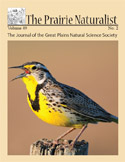Great Plains Natural Science Society
Date of this Version
6-2019
Document Type
Article
Citation
The Prairie Naturalist • 51(1): June 2019, p 41
Abstract
A Field Guide to the Natural World of the Twin Cities has two foci: natural areas in the Twin Cities of Minnesota and the species that live in each. The geographical scope is the seven counties that envelop Minneapolis and Saint Paul. The author describes nine major habitat types that can be found there: prairie, savanna, big woods, oak woods, wetlands (marshes and swamps), fens and bogs, lakes, rivers, and urban and suburban. It is useful to know that “big woods” are not just woods that are large in extent, but woodlands that occur in Minnesota and western Wisconsin dominated by sugar maple (Acer saccharum), American basswood (Tilia americana), American elm (Ulmus americana), and white oak (Quercus alba; although some sources say red oak [Quercus rubra] rather than white oak). The book’s Introduction provides a useful start to navigating through the information in the book. Each habitat type merits a color-coded section, introduced with a two-page photo by Siah L. St. Clair.
Included in
Biodiversity Commons, Botany Commons, Ecology and Evolutionary Biology Commons, Natural Resources and Conservation Commons, Systems Biology Commons, Weed Science Commons


Comments
Copyright © 2019 The Great Plains Natural Science Society